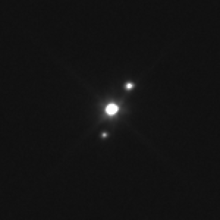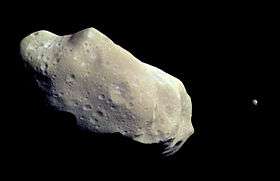Namaka (moon)
Namaka is the smaller, inner moon of the possible dwarf planet Haumea. It is named after Nāmaka, the goddess of the sea in Hawaiian mythology and one of the daughters of Haumea.
 In this photo taken by the Hubble Space Telescope, Namaka is the faint spot near the bottom, directly below Haumea (center). | |
| Discovery | |
|---|---|
| Discovered by | Michael E. Brown, Chad Trujillo, David Rabinowitz, et al. |
| Discovery date | 30 June 2005 |
| Designations | |
Designation | Haumea II |
| Pronunciation | /nɑːˈmɑːkə/ Hawaiian: [naːˈmɐkə] |
| (136108) 2003 EL61 II S/2005 (2003 EL61) 2 | |
| Orbital characteristics[1] | |
| Epoch JD 2454615.0 | |
| 25657±91 km[1] | |
| Eccentricity | 0.249±0.015 (in 2009; variable) |
| 18.2783±0.0076 d[1] | |
| 178.5°±1.7° | |
| Inclination | 113.013°±0.075° 13.41°±0.08° relative to Hiʻiaka (in 2008; variable) |
| 205.016°±0.228° | |
| 178.9°±2.3° | |
| Satellite of | Haumea |
| Physical characteristics | |
Mean radius | ~85 km (if albedo is same as primary's 0.7±0.1) |
| Mass | 1.79 ± 1.48×1018 kg[1] (0.05% the mass of Haumea) |
Mean density | (assumed to be near 1 g/cm3) |
| Albedo | 0.8±0.2[2][3] |
| Temperature | 32±3 K |
| 21.9 (4.6 difference from primary's 17.3)[2] | |
Discovery
Namaka was discovered on 30 June 2005 and announced on 29 November 2005.[4] It was nicknamed "Blitzen" by the discovery team before being assigned an official name.
Physical characteristics
Namaka is only 1.5% as bright as its parent dwarf planet Haumea[5] and is about 0.05% its mass. If it turns out to have a similar albedo, it would be about 170 km in diameter.[2] Photometric observations indicate that its surface is made of water ice.[5] Mutual events between 2009 and 2011[6] were expected to improve the knowledge of the orbits and masses of the components of the Haumean system,[3] but interpreting those observations was greatly complicated by the unexpected non-tidally locked spin state of Hiʻiaka, the larger moon. Further observations of Hiʻiaka might allow to determine its rotation period and spin state more precisely, at which point it should be possible to remove its effect from the data obtained in 2009.[7][8]
See also
Notes
References
- Ragozzine, D.; Brown, M. E. (2009). "Orbits and Masses of the Satellites of the Dwarf Planet Haumea (2003 EL61)". The Astronomical Journal. 137 (6): 4766–4776. arXiv:0903.4213. Bibcode:2009AJ....137.4766R. doi:10.1088/0004-6256/137/6/4766.CS1 maint: ref=harv (link)
- Wm. Robert Johnston (17 September 2008). "(136108) Haumea, Hi'iaka, and Nāmaka". Retrieved 18 September 2008.
- Ragozzine, D.; Brown, M. E. (2009). "Orbits and Masses of the Satellites of the Dwarf Planet Haumea (2003 EL61)". The Astronomical Journal. 137 (6): 4766–4776. arXiv:0903.4213. Bibcode:2009AJ....137.4766R. doi:10.1088/0004-6256/137/6/4766.CS1 maint: ref=harv (link)
- Green, Daniel W. E. (1 December 2005). "IAUC 8636". Retrieved 14 November 2018.
- Barkume, K. M.; Brown, M. E.; Schaller, E. L. (2006). "Water Ice on the Satellite of Kuiper Belt Object 2003 EL61" (PDF). The Astrophysical Journal. 640 (1): L87–L89. arXiv:astro-ph/0601534. Bibcode:2006ApJ...640L..87B. doi:10.1086/503159.
- Brown, M. "Mutual events of Haumea and Namaka". Retrieved 18 February 2009.
- Hastings, Danielle M; Ragozzine, Darin; Fabrycky, Daniel C; Burkhart, Luke D; Fuentes, Cesar; Margot, Jean-Luc; Brown, Michael E; Holman, Matthew (2016). "The Short Rotation Period of Hiʻiaka, Haumea's Largest Satellite". The Astronomical Journal. 152 (6): 195. arXiv:1610.04305. Bibcode:2016AJ....152..195H. doi:10.3847/0004-6256/152/6/195.
- Grundy, W. M; Benecchi, S. D; Rabinowitz, D. L; Porter, S. B; Wasserman, L. H; Skiff, B. A; Noll, K. S; Verbiscer, A. J; Buie, M. W; Tourtellotte, S. W; Stephens, D. C; Levison, H. F (2012). "Mutual Events in the Cold Classical Transneptunian Binary System Sila and Nunam". Icarus. 220 (1): 74–83. arXiv:1204.3923. Bibcode:2012Icar..220...74G. doi:10.1016/j.icarus.2012.04.014.


